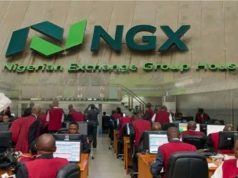THUR 01 JULY, 2021-theGBJournal- In the Banking sector, key players’ have demonstrated a commendable level of resilience despite the peculiar circumstances of the relatively weak and riskier environment as well as increasingly tight liquidity positions.
We expect a combination of (1) improved fixed-income yields and (2) relatively stronger risk asset creation, (3) FX revaluation gains from the adoption of the I&E window rate, and (4) strong balance sheet management to support performance for the financial period. Accordingly, we remain ‘Overweight’ the sector and our picks are ACCESS (BUY; TP:NGN14.04/s), GTCO (BUY; TP: NGN39.46/s), UBA (BUY; TP: NGN11.57/s), and ZENITHBANK (BUY; TP: NGN32.21/s).
Risk Asset Creation Resilient despite Cautionary Environment:
Considering the peculiarity of last year, both global and local banks were largely conservative in risk asset creation following the increased risks from the weakened economic and business environments. However, there has been an improvement in risk asset creation as reflected in the increased credit to the private sector – up 10.1% y/y to NGN31.82 trillion in April 2021, according to the Central Bank of Nigeria. Total loans to the private sector advanced by 4.4% q/q in Q1-2021 and 12.0% y/y.
Understandably, some caution is still being exercised in ramping up risk assets considering the overall risk environment, especially in the absence of the regulatory forbearances on loans that moderated the impact of the pandemic on asset quality last year (non-performing loans as at FY-2020: 4.7% vs FY2019: 5.5%).
A clearer representation of the admonitory note surrounding the lingering effects of the pandemic is reflected in the cost of risk, which remained flat (at 0.7% y/y in Q1-2021) despite an increase in total loans, therefore highlighting the higher impairment charges recorded.
In contrast to last year, we expect loan write-offs and restructuring to reflect current realities better. Consequently, we expect NPLs to edge higher by FY-2021 as already indicated (Q1-2021: 4.8%; FY-2020: 4.7%).
However, as risk asset creation accelerates at a faster pace in the medium term, we expect that players’ ability to defend their asset quality would stem from tilting weights in the portfolio book to prioritise sub-sectors like telecommunications, transportation, and agriculture that have remained resilient amid the tepid recovery conditions.
We highlight that the extent of risk management reflected in loan recovery would be increasingly important for banks in 2021 when considering the implication of higher NPLs on dividend payout ratios and, consequently,investors’ sentiments.
Profitability Driven by Cautious Gains across Segments:
As noted earlier, loans to the private sector increased, which as a standalone should have ordinarily resulted in higher aggregate net interest income across the sector. However, net interest income margin settled lower – 5.6% y/y in Q1-2021 relative to 6.3% in 2020, mainly due to competition resulting from the LFR/LDR policy as banks had to reduce interest on loans in a bid to win business. Illustratively, in the last quarter of the prior year, interest income which stood at NGN791.60 billion, moderated by 0.4% y/y to NGN788.48 billion in Q1-21.
In our view, there is still some opportunity for players to leverage on the expanding and profitable retail segment of loan creation. However, overall growth in risk assets would be less aggressive in the near term due to the current weak macro environment.
Also, compared to the low levels recorded last year on Treasury bonds and bills (FY-2020 average yields at 8.3% and 5.2%, respectively), fixed income yields have risen significantly (H1-2021 average yields at 10.1% and 5.0%, respectively). Thus, in our view, improved FI yields should partly offset reduced income from loans, which we expect to persist in part due to our outlook on risk asset creation.
Contrastingly, non-funded income growth has been relatively good in the year so far, with net fees and commissions significantly contributing to overall profitability as banks have leveraged technology in improving service delivery to clients. However, the recent tug-of-war between telecommunications companies (telcos) and banks poses a challenge to the growth momentum of this line if parties fail to reach a truce.
Regarding efficiency, the cost to income ratio (CIR) across the sector in the first quarter slightly increased by 0.7% y/y to 66.2%, primarily due to a decline in operating income as operating expense growth has remained well tethered. Overall, despite the slow start for most banks (gross earnings: -3.4% y/y), relative savings on tax and business travel expenses have trickled down to support overall profitability (PBT: +3.7% y/y) in Q1-2021.
Going into H2-2021, we envisage that the pressure on net interest rate margin could tether core income growth considering the upward pressure on the cost of funding across the sector. Similarly, the return to physical work and resumption in business travelling could exert upward pressure on operating expenses compared to last year and possibly constrain earnings expansion. However, summarily, we remain cautiously optimistic about growth in earnings over FY2021, which we expect to be mainly driven by higher yields on assets and the improved business environment relative to the prior year, even as macrofundamentals remain pressured.
Illiquidity Trends Present as New Normal:
The apex bank’s strategy of enforcing the intermediatory role of commercial banks through the LFR/LDR policy has resulted in increasing, and sizeable CRR debits given the weak asset creation in the prior year. This has continued to pressure banks as it has impacted liquidity significantly – leading to high interbank borrowing rates; overnight lending rate (H1-2021* average: 12.0% vs H1-2020: 8.3%). In a bid to provide some respite to tight liquidity positions, the CBN issued a Special Bill worth NGN4.20 trillion of 90-day notes at 0.5% in December 2020, which has been rolled over twice in 2021 – March and June –, with yields on the bills maintained at 0.5% on both occasions.
However, we saw these instruments being keenly traded in the secondary market and yields trending northwards to record highs of about +9.7% on June 11, 2021. Despite this, the tight liquidity positions banks have been dealt with has seemingly been increasing, as depicted by the worsening liquidity ratio (Q1-2021: 42.1% vs FY-2020: 45.1%).
Considering the regulator’s irrational utilisation of CRR debits and the limited CRR credits to players that have successfully improved their loan-to-deposit ratio, the liquidity within the sector is expected to remain depressed through H2-2021. For better context, LDR for Tier 2 banks increased by 3.4% to 65.3%, while restricted deposits conflictingly increased by 12.7% q/q in Q1-21. Consequently, we reiterate that the ability to improve profitability this year will stem from new innovative ways to add value to the expanding client base as traditional sources of income generation remain overstretched in the current economic environment.
Timely Improvements in Capital adequacy:
All players under review exceed the minimum capital adequacy threshold stipulated by the regulatory authority across the sector. In the past quarter, banks have built a more robust capital buffer (CAR: 20.6% in Q1-2021 relative to 19.3% as of FY-2020) due to increased bottom-line earnings. This signals an improved ability to expand their risk asset creation without raising additional capital or incurring additional costs from interest-bearing liabilities.
After considering motivations to avoid possible infringements of the statutory guidelines and ensuing fines, we anticipate continued efforts to retain more earnings that would serve as an additional source for risk assets creation which could be considered banks’ primary objective in this winding path to recovery.
Decomposing by sector tiers, we believe Tier-1 banks – like Access and GTB – are better positioned to expand risk assets in FY-2021 compared to their Tier-2 counterparts (CAR growth of +2.2% and +0.7% q/q, respectively in Q1-21).
We Remain ‘Overweight’ on the Sector:
Banking sector stocks underperformed the market in H1-2021, using the NGX’s Banking-10 index as a proxy (-6.9% YTD return as of June 29, 2021, compared to the ASI: -6.5%). Granted, this was widespread as market participants returned to the fixed income markets enmasse to take advantage of higher risk-free yields.
We, therefore, expect that as fixed-income yields approach an inflexion point, investors’ demand for fundamentally sound and resilient banking stocks will spur improved price performance.- Analysis is provided by Cordros Research
Twitter-@theGBJournal|Facebook-The Government and Business Journal|email: govandbusinessj@gmail.com









